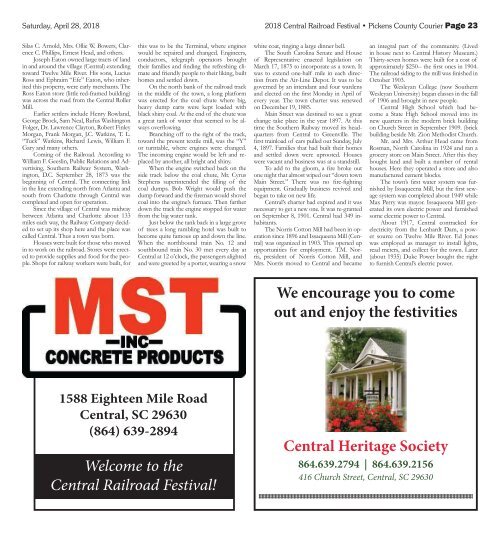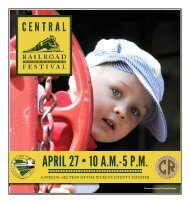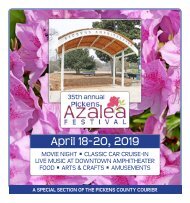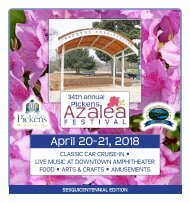Create successful ePaper yourself
Turn your PDF publications into a flip-book with our unique Google optimized e-Paper software.
Saturday, April 28, <strong>2018</strong> <strong>2018</strong> Central <strong>Railroad</strong> <strong>Festival</strong> • Pickens County Courier Page 23<br />
Silas C. Arnold, Mrs. Ollie W. Bowers, Clarence<br />
C. Phillips, Ernest Head, and others.<br />
Joseph Eaton owned large tracts of land<br />
in and around the village (Central) extending<br />
toward Twelve Mile River. His sons, Lucius<br />
Ross and Ephraim “Efe” Eaton, who inherited<br />
this property, were early merchants. The<br />
Ross Eaton store (little red-framed building)<br />
was across the road from the Central Roller<br />
Mill.<br />
Earlier settlers include Henry Rowland,<br />
George Brock, Sam Neal, Rufus Washington<br />
Folger, Dr. Lawrence Clayton, Robert Finley<br />
Morgan, Frank Morgan, J.C. Watkins, T. L.<br />
“Tuck” Watkins, Richard Lewis, William F.<br />
Gary and many others.<br />
Coming of the <strong>Railroad</strong>. According to<br />
William F. Geeslin, Public Relations and Advertising,<br />
Southern Railway System, Washington,<br />
D.C. September 28, 1873 was the<br />
beginning of Central. The connecting link<br />
in the line extending north from Atlanta and<br />
south from Charlotte through Central was<br />
completed and open for operation.<br />
Since the village of Central was midway<br />
between Atlanta and Charlotte about 133<br />
miles each way, the Railway Company decided<br />
to set up its shop here and the place was<br />
called Central. Thus a town was born.<br />
Houses were built for those who moved<br />
in to work on the railroad. Stores were erected<br />
to provide supplies and food for the people.<br />
Shops for railway workers were built, for<br />
this was to be the Terminal, where engines<br />
would be repaired and changed. Engineers,<br />
conductors, telegraph operators brought<br />
their families and finding the refreshing climate<br />
and friendly people to their liking, built<br />
homes and settled down.<br />
On the north bank of the railroad track<br />
in the middle of the town, a long platform<br />
was erected for the coal chute where big,<br />
heavy dump carts were kept loaded with<br />
black shiny coal. At the end of the chute was<br />
a great tank of water that seemed to be always<br />
overflowing.<br />
Branching off to the right of the track,<br />
toward the present textile mill, was the “Y”<br />
or turntable, where engines were changed.<br />
The incoming engine would be left and replaced<br />
by another, all bright and shiny.<br />
When the engine switched back on the<br />
side track below the coal chute, Mr. Cyrus<br />
Stephens superintended the filling of the<br />
coal dumps. Bob Wright would push the<br />
dump forward and the fireman would shovel<br />
coal into the engine’s furnace. Then farther<br />
down the track the engine stopped for water<br />
from the big water tank.<br />
Just below the tank back in a large grove<br />
of trees a long rambling hotel was built to<br />
become quite famous up and down the line.<br />
When the northbound train No. 12 and<br />
southbound train No. 30 met every day at<br />
Central at 12 o’clock, the passengers alighted<br />
and were greeted by a porter, wearing a snow<br />
white coat, ringing a large dinner bell.<br />
The South Carolina Senate and House<br />
of Representative enacted legislation on<br />
March 17, 1875 to incorporate as a town. It<br />
was to extend one-half mile in each direction<br />
from the Air-Line Depot. It was to be<br />
governed by an intendant and four wardens<br />
and elected on the first Monday in April of<br />
every year. The town charter was renewed<br />
on December 19, 1885.<br />
Main Street was destined to see a great<br />
change take place in the year 1897. At this<br />
time the Southern Railway moved its headquarters<br />
from Central to Greenville. The<br />
first trainload of cars pulled out Sunday, July<br />
4, 1897. Families that had built their homes<br />
and settled down were uprooted. Houses<br />
were vacant and business was at a standstill.<br />
To add to the gloom, a fire broke out<br />
one night that almost wiped out “down town<br />
Main Street.” There was no fire-fighting<br />
equipment. Gradually business revived and<br />
began to take on new life.<br />
Central’s charter had expired and it was<br />
necessary to get a new one. It was re-granted<br />
on September 8, 1901. Central had 349 inhabitants.<br />
The Norris Cotton Mill had been in operation<br />
since 1896 and Issaqueena Mill (Central)<br />
was organized in 1903. This opened up<br />
opportunities for employment. T.M. Norris,<br />
president of Norris Cotton Mill, and<br />
Mrs. Norris moved to Central and became<br />
an integral part of the community. (Lived<br />
in house next to Central History Museum.)<br />
Thirty-seven homes were built for a cost of<br />
approximately $250-- the first ones in 1904.<br />
The railroad siding to the mill was finished in<br />
October 1903.<br />
The Wesleyan College (now Southern<br />
Wesleyan University) began classes in the fall<br />
of 1906 and brought in new people.<br />
Central High School which had become<br />
a State High School moved into its<br />
new quarters in the modern brick building<br />
on Church Street in September 1909. (brick<br />
building beside Mt. Zion Methodist Church.<br />
Mr. and Mrs. Arthur Head came from<br />
Rosman, North Carolina in 1924 and ran a<br />
grocery store on Main Street. After this they<br />
bought land and built a number of rental<br />
houses. Here they operated a store and also<br />
manufactured cement blocks.<br />
The town’s first water system was furnished<br />
by Issaqueena Mill, but the first sewage<br />
system was completed about 1949 while<br />
Max Perry was mayor. Issaqueena Mill generated<br />
its own electric power and furnished<br />
some electric power to Central.<br />
About 1917, Central contracked for<br />
electricity from the Lenhardt Dam, a power<br />
source on Twelve Mile River. Ed Jones<br />
was employed as manager to install lights,<br />
read meters, and collect for the town. Later<br />
(about 1935) Duke Power bought the right<br />
to furnish Central’s electric power.<br />
We encourage you to come<br />
We encourage you to come out and<br />
out and enjoy the festivities<br />
enjoy the festivities<br />
Central Heritage Society<br />
1588 Eighteen Mile Road<br />
Central, SC 29630<br />
(864) 639-2894<br />
Welcome to the<br />
Central <strong>Railroad</strong> <strong>Festival</strong>!<br />
We encourage you to come out and<br />
864.639.2794 | 864.639.2156 enjoy the festivities<br />
416 Church Street Central, SC 29630<br />
Central Heritage Society<br />
Central Heritage Society<br />
864.639.2794 | 864.639.2156<br />
416 Church Street Central, SC 29630<br />
864.639.2794 | 864.639.2156<br />
416 Church Street, Central, SC 29630






